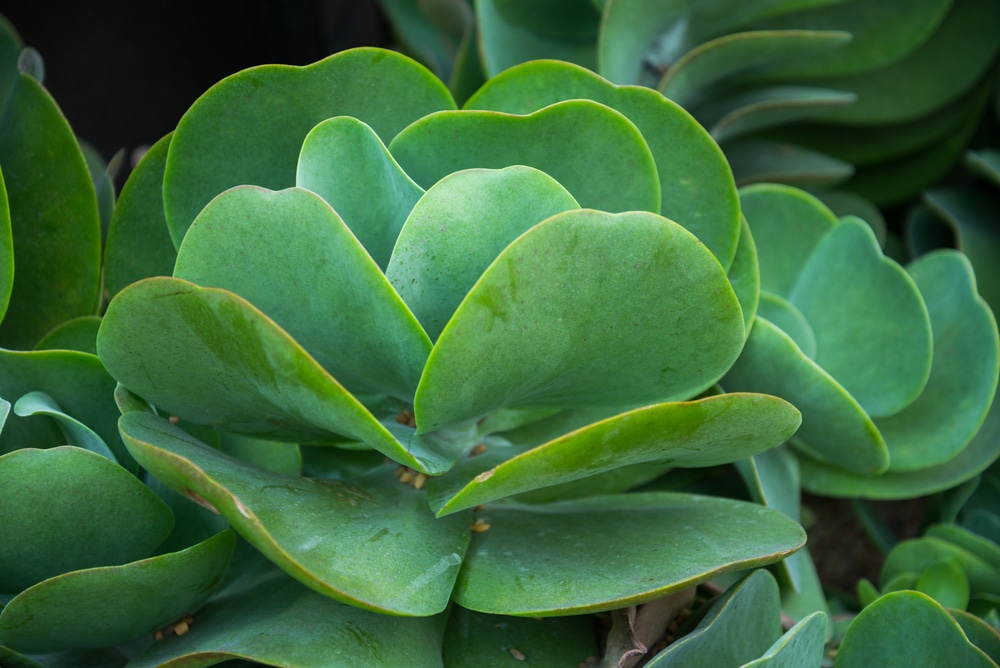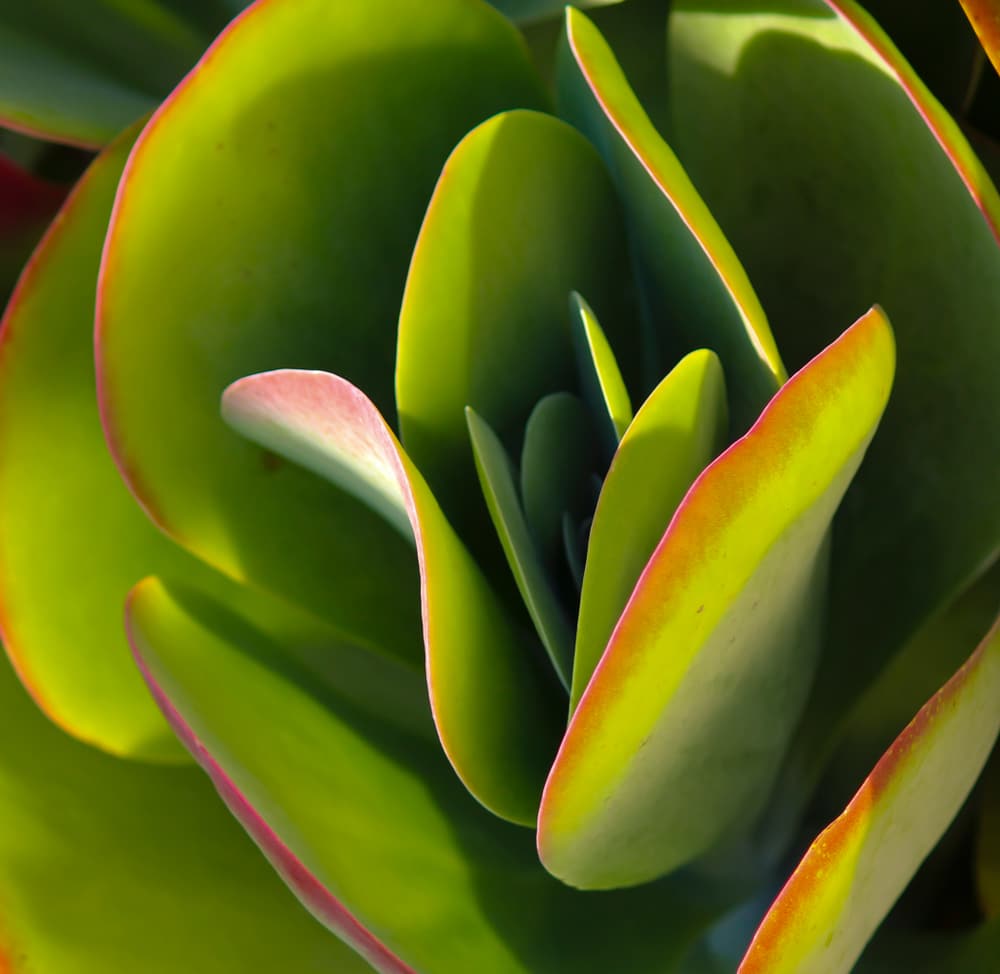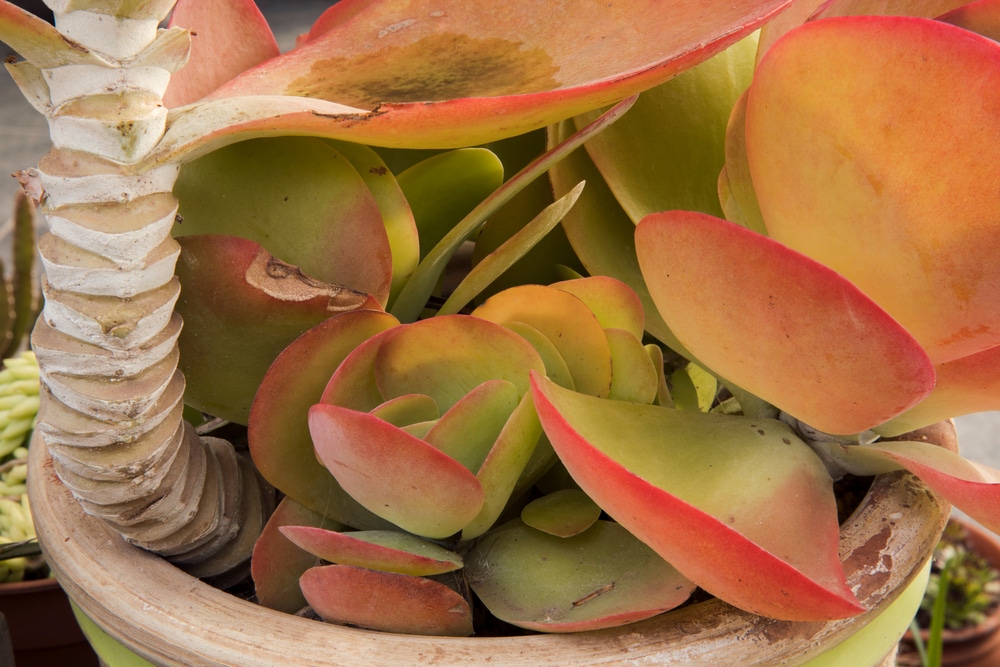My paddle plants never cease to be a topic of discussion when my friends come by place. With this article, you will be able to impress your friends with your very own healthy succulent!
Continue reading because we outline all the care tips and offer a guide for growing healthy and problem-free paddle plants.

Noteworthy Characteristics
Paddle plants are native to South Africa. They also go by other common names including flapjack plant, desert cabbage, and dog tongue. It earns the name flapjack because of its fleshy leaves resembling a stack of flapjacks or paddles.
Although many species and cultivars of kalanchoe are grown for the colorful flower displays, flapjacks are grown for their showy leaves. The large succulent and oval leaves, as well as their growth habit, add interest and texture to gardens, as well as containers used outside and indoors. The flat leaves don’t have a stem and are bunched together in the center rosette.
These are tropical succulents and, as such, require warmth and sun for good growth. However, you don’t have to be an expert to give them good care and keep them healthy.
The genus Kalanchoe is quite large and diverse and is a member of the stonecrop family Crassulaceae. Paddle plant is the common name of two species of kalanchoe, the more common Kalanchoe luciae and the rarer species Kalanchoe thyrsiflora. Both of these are succulents and although they vary slightly in looks, both have the same requirements of preferred cultural conditions and care.
Even horticulturists have problems telling Kalanchoe luciae and Kalanchoe thyrsiflora apart, which leads to confusion between the two. Many times, you have to wait until the flapjack blooms to distinguish which succulent you have.

Kalanchoe thyrsiflora
K. thyrsiflora is native to exposed the desert and rocky areas of South Africa and Botswana, making it a drought-tolerant succulent. This paddle plant forms a center basal rosette with large succulent and fleshy leaves that are stalkless and paddle-shaped. The chalky grayish-green leaves are stacked around each other like pancakes. The foliage is a bit smaller than that of Kalanchoe luciae.
The basal rosette typically grows around 12 inches tall and about half as wide. The leaves are around 6 inches long with rounded edges and are held upright within the center rosette and are slightly cupped. All the leaves are covered in a white powdery-like coating of wax, and unlike K. luciae, they rarely take on a reddish or pink coloration.
When given enough sunlight and warmth during the winter months, paddle plant Kalanchoe thyrsiflora produces a bloom during late winter or spring. A tall flower spike around 30 inches tall forms from the center basal rosette. The bright yellow and urn-shaped flowers with reflexed petals form into dense and cylindrical spike-like clusters on the tall leafy flower stalk. The flowers are very fragrant. However, Kalanchoe thyrsiflora only blooms once the succulent reaches maturity, which can take three or four years.

Kalanchoe luciae
Like Kalanchoe thyrsiflora, Kalanchoe luciae is a South African native but is also native to areas of Mozambique and Zimbabwe. This flapjack develops a center rosette filled with fleshy and grayish-green to yellowish-green leaves. The flat leaves can be tinged in red or, if conditions are right, can turn almost entirely red, especially if grown in bright light during winter. Leaves grow up to 6 inches long and around 4 inches wide.
Kalanchoe luciae grow around 2 feet tall and wide. When you take into account its preferred native habitat and the succulent resembling a head of cabbage, it’s easy to see how it received another common name, desert cabbage.
If given an adequate amount of sunlight and warmth, Kalanchoe luciae will produce a tall flower stalk from the center rosette and blooms in late winter to early spring. The flower stalk of around 3 feet or taller fills with dense spike-like clusters of white to pale-yellow flowers. Unlike Kalanchoe thyrsiflora, the flowers aren’t very fragrant.
However, similar to K. thyrsiflora, Kalanchoe luciae won’t produce any flowers until they mature. This can take up to four years, and once the succulent flowers, the mother plant dies but produces offsets.
Kalanchoe luciae holds the prestigious honor of being a winner of the Garden Merit Award from the Royal Horticultural Society.

Cultural Requirements
Growing paddle plants in their preferred cultural conditions and giving them the basic care leads to flourishing and hardy plants. Whether grown indoors, outside in the garden, or in a pot, they are considered low-maintenance succulent. However, they do need their various preferences met for continued problem-free growth.
Preferred Climate Conditions
Both types of kalanchoe are native to consistently warm regions. Therefore, if you will be growing in an outdoor garden, it will require a frost-free climate for the best growth. Although the paddle plant can survive when temperatures range in the upper to mid-20℉s, the succulent leaves suffer damage when temperatures hit around 30℉. Both K. thyrsiflora and K. luciae will grow best in outdoor gardens that don’t dip much below 50℉ in winter.
If your particular location or hardiness zone tends to experience frosts and freezes during winter, you can either grow both succulents in pots or dig them out of the garden before cold weather strikes. Bring your succulent into a protected, warm indoor location inside the home until the weather warms in spring. When grown indoors, both succulents prefer a location where indoor temperatures range around 60℉.
Ideal Light Conditions
Both types of kalanchoe require a good amount of sunlight to grow properly. If flapjacks don’t receive enough light, the growth tends to be long and straggly.
Outdoor Light Conditions
If growing the succulents outside, they tolerate everything from full sun to partial sun. However, full sun promotes the best growth and reddish coloration of the leaves on Kalanchoe luciae. If your location experiences intense summer heat and sunlight, you can situate the paddle plant where it receives a bit of shade during the heat of the afternoon. Six hours of full sun produces the best performance.

Indoor Light Conditions
Both types of kalanchoe grow well as houseplants, provided they get everything they need for healthy growth, which includes light. They that require bright light for the best performance, but this doesn’t mean allowing the leaves to butt directly against a glass window. Situating the kalanchoes directly in a hot window may cause entire leaves or leaf tips to suffer burning, especially during the hot months of summer.
It’s best to situate the succulent by a south- or west-facing window where it will receive bright but indirect light. As long as it sits on a table close to the window but not directly in it, the succulent will receive all the full sun and light it needs for healthy indoor growth. If necessary, you can consider buying an indoor grow light.
If you brought an outdoor kalanchoe inside your home for winter protection, be sure to harden it off to outdoor light conditions when you set it back outside in spring. Otherwise, the leaves may suffer burning if they haven’t had time to adjust to the outdoors’ intense sunlight.
Soil Conditions
Kalanchoe flapjacks will not tolerate soggy soil conditions and may develop rot and die if kept too moist. They tolerate a wide range of well-drained garden soils that don’t tend to retain too much water. In fact, the succulents grow well in sandy soils. Remember, they are native to hot and dry areas where cactus thrive and moisture can be at a premium.
If you are planting and growing the succulents in pots, make sure the pot has bottom drainage. This allows the medium to drain properly and not remain soggy. Use a potting mix that drains well or a potting mix used for cactus. Some types of straight potting soils are too heavy and remain too wet and may also lead to rot problems. You can lighten a heavy mix by adding equal parts of sterile sand or vermiculite to the mix.
Tips for Ongoing Care
Once you’ve planted your flapjack, it’s time for you to continue to attend to its care needs. Although succulents are considered low-maintenance, they still have particular irrigation and fertilizing needs. Good continued care will keep your paddle plant growing trouble-free for years.
Water Requirements
Watering at the proper time can mean the difference between your succulent remaining healthy and dying.
Like cactus and aloe, succulents don’t need vast amounts of water for proper growth. They store water in their fleshy leaves.
Giving the succulent more water than it needs can cause it to rot and die. A flapjack is more forgiving if you forget to water as opposed to overwatering.

Irrigating Plants in Containers
Checking to see if your succulent needs water is relatively simple, regardless of whether the container is inside the home or outdoors. You only need to irrigate when the soil becomes dry to the touch.
Stick your finger into the top of the container, and if the soil feels dry, water until it flows out of the bottom drain holes. If the container is outdoors and your summer is extremely hot and dry, you may have to irrigate a couple of times weekly. During winter, while the your plant goes through a dormancy period, cut back watering to once every several weeks.
Irrigating Plants in the Garden
You won’t be spending a lot of time irrigating your succulents planted directly in the landscape to keep them growing healthy. Many times, the flapjack paddle plant receives enough moisture from rains or sprinkler systems. However, like those grown in containers, you don’t want to keep the soil soggy as it promotes health problems.
New plantings require water several times a week for about a month while the it establishes itself. After that, depending on the weather, irrigate the succulents every week or so.
Since they are native to dry desert climates and drought-tolerant once established, the succulents would make great additions to rock gardens as an accent.
Fertilization Needs
When it comes to the fertilization, they are not big feeders and don’t require heavy doses of fertilizer. If you are growing the succulent in a container, many mixes contain a slow-release fertilizer incorporated into it. It’s not necessary to replace the fertilizer for around three months, as that’s how long it remains viable in the soil. You can replace it with additional general-purpose slow-release granules or apply a liquid feed.
When using a liquid fertilizer, use a water-soluble blend, such as a 10-10-10 mix applied at half-strength. Apply monthly as you irrigate the succulent. However, make sure to cease feeding the plant during winter while it goes through dormancy and stops active growth. You can resume fertilizing once it resumes growth in springtime.

Propagation Tips
You can propagate a new paddle plant through dividing offsets or by rooting leaf cuttings. Propagation of either offsets or cuttings of leaves is basic and is best done while the it is actively growing.
Offset Propagation
Although the plant dies after blooming, there are usually offsets forming around the mother called pups. Propagate by carefully lifting the offsets from the area around the dying or dead mother to retain the root system. Replant at the same depth they were originally growing in the landscape or into a container.
If propagating the offsets in a container, use one that has bottom drain holes filled with well-drained soil. Plant one succulent per each 1-gallon container at the same depth it was originally growing. Irrigate the soil and place it in a location with appropriate sunlight. Only irrigate when the soil becomes dry and don’t overwater. The new succulents should establish themselves in the soil in around four to six weeks.
Propagating Leaf Cuttings
As you can with many varieties of succulents, you can propagate new ones by rooting leaves. Of course, you will have to wait a bit longer to grow full-size succulents, but they are easy to propagate in this fashion.
The succulent leaves should easily snap from the rosette, and if not, you can gently remove each one by snipping it from the rosette. When removing, retain the entire leaf to propagate.
You can also root several cuttings in the same container by filling a tray with a well-drained soil mix. Just make sure the tray or container drains, or the cuttings can rot and die. Place each leaf slightly into the soil, being sure to cover the tipped end where it was attached to the rosette. Gently irrigate the soil so that you don’t dislodge the leaf, and place it in a location with appropriate sunlight.
Continue to irrigate the container several times weekly to moisten the soil. However, do not leave the soil soggy or overwater or the cutting can rot and fail to form roots. The succulents should start forming roots in around six to eight weeks. If you touch the leaf and it remains stiff and upright, it’s starting to form roots.
This guide should answer any of your paddle plant care questions. If you have any questions or comments, feel free to leave a comment below!

